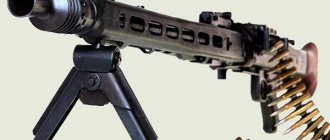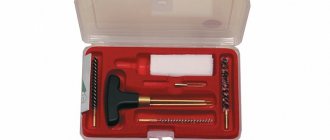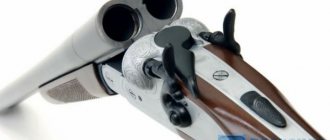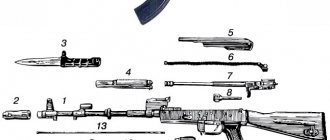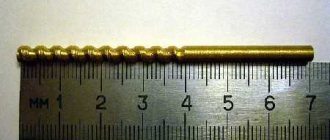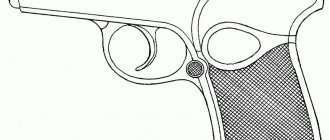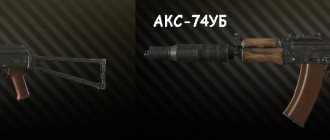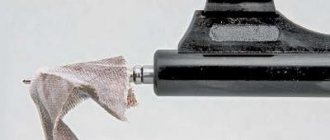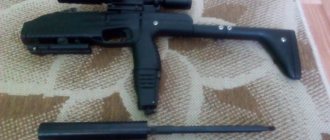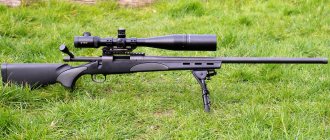Cleaning rifled weapons
Hello everyone) I’ll share here my cleaning method, which I optimized in terms of maximum results at minimal costs, both financial and time. Regular gun care is very important. This increases the resource, ensures uninterrupted operation of components and mechanisms, increases the accuracy and stability of fire. Proper cleaning does not take much time, and at the same time completely removes dirt from the barrel. Below we will look at a working algorithm that is effective both in terms of time invested and in terms of price-quality ratio, and we will clearly see what happens in the barrel. Of course, there is nothing cheaper than kerosene and ammonia - but not everyone has the opportunity to clean weapons in well-ventilated non-residential premises)
Let's look at this topic using the example of the civilian version of the AKM, the VPO-136 carbine. In principle, this method is quite universal; I use it on all my weapons, with minor modifications depending on the type of carbine. Write in the comments if there is a need to discuss cleaning under bolted systems where there are claims to accuracy. There are a couple of nuances in chemistry and methodology.
So, let's begin. We disconnect the magazine, remove the fuse, and check that there is a cartridge in the chamber. After this, you can begin partial disassembly - for ordinary cleaning, I leave only the trigger in place. The buttstock is removable to make it easier to work with a cleaning rod - this is easier than removing the cheekpiece, since on this model you need a hexagon for this.
Before cleaning, let's see what condition the barrel is in. We run a couple of dry patches through the barrel and look with a borescope.
We will control two areas - at the beginning of the rifling, immediately behind the chamber, and in the middle of the barrel, in the area of the gas outlet. As you can see, the barrel is quite seasoned - more than 5000 rounds fired. Cleaning will be thorough, although I did not immediately come to the understanding that this is really necessary for this weapon system.
We will carry out all work with the barrel from the chamber side. The military habit of cleaning from the muzzle always leads to damage to the exit from the rifling, with a subsequent deterioration in accuracy.
This video clearly shows characteristic damage associated with improper cleaning of the barrel.
Well, let's start cleaning. The chemicals were selected according to the combination of price and quality. We will need:
- cleaning rod with an aluminum visor (for AKM I use a clean gun)
- bronze brush (in terms of lifespan, Dewey showed itself to be better than others)
- nylon brush (optional)
- patches (below I’ll tell you which ones I use)
- copper stripping foam (I use Neo Elements) (optional)
- water-soluble chemicals that work with carbon deposits and copper (for AKM I use Treal-M)
- neutral gun oil (I use Neo Elements)
- cleaning paste (I use Iosso) (optional)
Let me explain the choice of patches. They are made of non-woven material and do not leave any lint in the trunk. Chemicals are perfectly applied to them, they are thin, and the number of patches pinned onto the visher can be adapted for cleaning of any caliber. Well, the icing on the cake is that they are cheap. This pack of 900 patches costs about 100 rubles when ordering on Ali Express.
The first step in cleaning is to foam the barrel. This step can be skipped if the cleaning is urgent and we are in a hurry. If you can leave the barrel to soak for an hour, then this is a good way to make further cleaning easier.
We block the gas outlet hole with a cotton swab, and to prevent foam from protruding from the breech, we insert the patches tightly into the chamber with a visher together with a foam tube. In systems where the gas outlet hole is smaller and drilled vertically, we tightly block the entire hole for the entrance of the gas piston with a napkin.
Foam the barrel and leave it like that for an hour. While the barrel is soaking, you can start cleaning the frame and bolt.
For this we will use Treal-M. It copes well with soot. I douse the entire bolt, and on the frame I clean those parts that experience friction when the automation is operating. In particularly severe cases, you can leave the parts to soak in the product. We wait 5 minutes and wipe everything with napkins and cotton swabs.
I use disposable napkins, they are sold in household stores as intended for cleaning, like patches, they are non-woven and do not leave lint, they are sold in many places, I buy them in Auchan for 100 rubles per roll.
After cleaning, all that remains is to lubricate the moving parts, and you can return to the barrel.
For lubrication I use neutral oil from Neo Elements. There were attempts to use Teflon lubricant - the smooth operation of the shutter was worse. We lubricate the rubbing parts and return to the barrel.
We expel the foam with a dry patch and begin the cleaning cycles. We use Treal-M as a chemical; it works great with carbon deposits and copper plating. One cycle will include passes with patches soaked in chemicals, passes with a bronze brush soaked in chemicals, and a pass with a control patch. Let's look at all the stages in detail.
1. Pass with three patches moistened with Treal-M
2. Passages with a bronze brush. We take it beyond the muzzle, apply Treal-M to it, and make 50 movements (25 times back and forth). When leaving the muzzle and the breech, we turn the brush to compensate for possible misalignment of the brush attachment to the cleaning rod, and thus have the same effect on all parts of the barrel
When working with a brush, it is very useful to use a catcher at the end of the barrel, as it will be quite dirty, plus needles will fly. A couple of times I picked them up from the floor with my feet, nothing pleasant. So it’s better to adapt at least a bottle, or use a specialized solution.
After each use, clean the brush from carbon deposits and chemicals with water. This way the brush will last longer and will go bald less.
Also, do not forget to wipe the cleaning rod from chemical residues mixed with soot particles and dissolved copper.
3. We pass a control dry test patch through the barrel
The number of cycles depends on the contamination of the barrel. Above we see that gradually the carbon deposits go away and a blue color appears on the patches. In this case, this is not necessarily related to copper plating - since we are adding Treal-M to a bronze brush, but it definitely shows us the removal of carbon deposits from the barrel.
Three cycles were enough for us to see the blue color. This indicates that the carbon deposits have been largely removed, so let's take a look into the barrel again with the borescope.
What do we see? The main part of carbon deposits and copper has been removed. All that was left were carbon deposits and some copper where the chrome had chipped. It is VERY IMPORTANT not to stop here, but to move on and remove carbon deposits. Why? This is on my barrel, which I clean with paste every time, there are few carbon deposits left. But if I ignore the procedure for removing carbon deposits over and over again, there will be much more of them, which will not only worsen the accuracy characteristics, but will also lead to premature wear.
Is it possible to do without pasta? In principle, by increasing the number of cycles, you can combat the remaining carbon deposits. But it’s much faster to do this with Iosso cleaning paste (not to be confused with polishing paste). It removes copper and carbon deposits quickly and effectively.
Apply the paste to the patch, and rub it on the trunk with short movements back and forth.
Next, apply the paste to the nylon brush, filling it completely.
\
When working with a nylon brush, it is important not to go beyond the edge of the barrel, so during the first pass, close the muzzle with your finger and move the cleaning rod all the way. We mark in a convenient way the permissible depth of work (I use a strip of masking tape), and make 30 movements (15 back and forth), holding the cleaning rod by the body, and not by the handle. Wash the paste off the brush with hot water.
Our next task is to expel the paste from the trunk. To do this, we use the already known cycle of patches with chemistry - brush with chemistry - control patch. Only now we use a nylon brush.
The remaining paste is soft and there is no need for a bronze brush. This way we save the resource of bronze brushes, and we are also guaranteed not to leave needles in the barrel.
Three more cycles and the barrel is clean. Let's look again with a borescope and compare with previous results. The left part is what we got after three cycles, the right part after the paste. The difference does not seem big, but in fact it is fundamental and very important. If you don't clean it enough each time and leave carbon deposits in the barrel, it will quickly become a problem.
Due to the age and condition of the barrel, there is still some contaminant remaining in the cracks and chips of the chrome, but overall it can be said that most of it has been removed. Next, check out the gallery before and after all the cleaning for all the areas of the barrel that we monitored.
Let's finish cleaning) Wipe the barrel dry with patches. Since Treal-M is non-aggressive to the metal of the barrel, it can not be washed off, but simply wiped dry. We've finished with the barrel, it's just a matter of work.
Remove the cotton swab and wipe the mainspring, receiver cover, and gas piston rod with a dry cloth. I don’t see the point in cleaning the gas chamber on an AKM, but where there are fewer holes, sometimes it is necessary. At the end of the cleaning, I use a napkin moistened with neutral oil to go along the guides of the bolt frame in the box, wipe the trigger and parts of the mechanism without disassembling. Next, we assemble the weapon and check the operation of the bolt and trigger. If, during previous use, the carbine was in aggressive conditions (snow, rain, fog, condensation), then I additionally wipe it with an anti-rust agent (I use Barricade from Birchwood Casey).
Something like this! You can, of course, get by with kerosene (removing carbon deposits) and ammonia (removing copper), but in apartments where the vast majority of users clean weapons, it is much safer to use water-soluble chemicals. For the same reasons, I do not use such popular (a little outdated, although still working perfectly) products like Butch, Sweet 7.62, etc., which are popular among many. If you have the opportunity to clean weapons on the street, then the above-mentioned products are perfect for you.
Accurate and accurate shots to you!
article taken from my Zen channel tochno.kuchno: https://zen.yandex.ru/tochno_kuchno
Adaptations
Among the main devices for cleaning rifled weapons are patches, machines, and box inserts. The process is carried out both on tables and on rugs. There are special mats that help reduce the risk of damaging both the table and the weapon. In addition, they absorb oil from patches that may fall randomly, which prevents everything around from getting dirty.
But the best solution is to use a special stand designed for cleaning rifled weapons after shooting. There is a wide range of such devices. So, there are special types for revolvers, which clamp the weapon in such a way that you can twist it as you like. Plastic stands are often used, which look like troughs with horns holding weapons. These are fairly simple devices that are easy to use and easy to clean.
They have compartments for oil, cans of solvents, and cleaning rod holders for cleaning rifled weapons. They are easy to fold and put away, they do not require much space, which is an advantageous difference from professional machines. In addition, their price is low. They usually cost 3,000 – 4,000 rubles, and the price of a professional set is 9,000 – 12,000 rubles.
To prevent oil from getting into the rifle magazine, inserts are used to clean rifled weapons. They look like small plastic shutters that fit in place of the stock shutter. Thanks to them, the process is greatly facilitated. Sometimes they have holes for oil and rubber seals. Most often, inserts are divided into sizes corresponding to different calibers, but you can often find a universal variety.
Experienced shooters testify that inserts need to be selected in accordance with the caliber. This choice is a matter of taste, since any insert will easily cope with its function.
To prevent the cleaning process from getting too messy, you need to purchase a patch catcher. It resembles a small container that is attached to the end of the barrel. Patches fall into it. Sometimes there are catchers with separate containers. However, many gun owners use homemade containers such as plastic bottles.
Their use is convenient as they are disposable. The rifle cleaning kit contains the most useful tools from the listed components.
